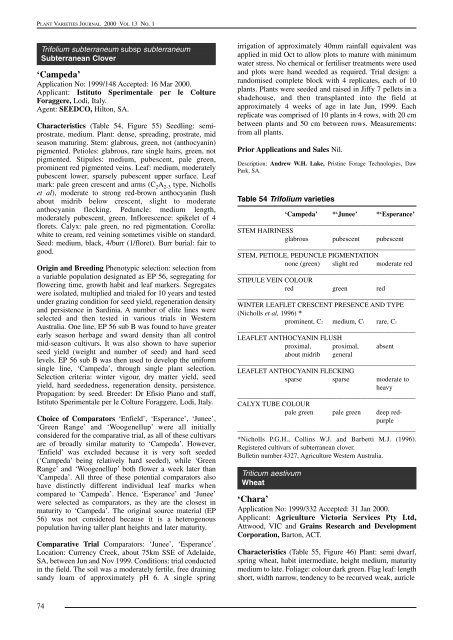53. Volume 13- Number 1 - IP Australia
53. Volume 13- Number 1 - IP Australia
53. Volume 13- Number 1 - IP Australia
You also want an ePaper? Increase the reach of your titles
YUMPU automatically turns print PDFs into web optimized ePapers that Google loves.
PLANT VARIETIES JOURNAL 2000 VOL <strong>13</strong> NO. 1<br />
Trifolium subterraneum subsp subterraneum<br />
Subterranean Clover<br />
‘Campeda’<br />
Application No: 1999/148 Accepted: 16 Mar 2000.<br />
Applicant: Istituto Sperimentale per le Colture<br />
Foraggere, Lodi, Italy.<br />
Agent: SEEDCO, Hilton, SA.<br />
Characteristics (Table 54, Figure 55) Seedling: semiprostrate,<br />
medium. Plant: dense, spreading, prostrate, mid<br />
season maturing. Stem: glabrous, green, not (anthocyanin)<br />
pigmented. Petioles: glabrous, rare single hairs, green, not<br />
pigmented. Stipules: medium, pubescent, pale green,<br />
prominent red pigmented veins. Leaf: medium, moderately<br />
pubescent lower, sparsely pubescent upper surface. Leaf<br />
mark: pale green crescent and arms (C 2 A 2-3 type, Nicholls<br />
et al), moderate to strong red-brown anthocyanin flush<br />
about midrib below crescent, slight to moderate<br />
anthocyanin flecking. Peduncle: medium length,<br />
moderately pubescent, green. Inflorescence: spikelet of 4<br />
florets. Calyx: pale green, no red pigmentation. Corolla:<br />
white to cream, red veining sometimes visible on standard.<br />
Seed: medium, black, 4/burr (1/floret). Burr burial: fair to<br />
good.<br />
Origin and Breeding Phenotypic selection: selection from<br />
a variable population designated as EP 56, segregating for<br />
flowering time, growth habit and leaf markers. Segregates<br />
were isolated, multiplied and trialed for 10 years and tested<br />
under grazing condition for seed yield, regeneration density<br />
and persistence in Sardinia. A number of elite lines were<br />
selected and then tested in various trials in Western<br />
<strong>Australia</strong>. One line, EP 56 sub B was found to have greater<br />
early season herbage and sward density than all control<br />
mid-season cultivars. It was also shown to have superior<br />
seed yield (weight and number of seed) and hard seed<br />
levels. EP 56 sub B was then used to develop the uniform<br />
single line, ‘Campeda’, through single plant selection.<br />
Selection criteria: winter vigour, dry matter yield, seed<br />
yield, hard seededness, regeneration density, persistence.<br />
Propagation: by seed. Breeder: Dr Efisio Piano and staff,<br />
Istituto Sperimentale per le Colture Foraggere, Lodi, Italy.<br />
Choice of Comparators ‘Enfield’, ‘Esperance’, ‘Junee’,<br />
‘Green Range’ and ‘Woogenellup’ were all initially<br />
considered for the comparative trial, as all of these cultivars<br />
are of broadly similar maturity to ‘Campeda’. However,<br />
‘Enfield’ was excluded because it is very soft seeded<br />
(‘Campeda’ being relatively hard seeded), while ‘Green<br />
Range’ and ‘Woogenellup’ both flower a week later than<br />
‘Campeda’. All three of these potential comparators also<br />
have distinctly different individual leaf marks when<br />
compared to ‘Campeda’. Hence, ‘Esperance’ and ‘Junee’<br />
were selected as comparators, as they are the closest in<br />
maturity to ‘Campeda’. The original source material (EP<br />
56) was not considered because it is a heterogenous<br />
population having taller plant heights and later maturity.<br />
Comparative Trial Comparators: ‘Junee’, ‘Esperance’.<br />
Location: Currency Creek, about 75km SSE of Adelaide,<br />
SA, between Jun and Nov 1999. Conditions: trial conducted<br />
in the field. The soil was a moderately fertile, free draining<br />
sandy loam of approximately pH 6. A single spring<br />
irrigation of approximately 40mm rainfall equivalent was<br />
applied in mid Oct to allow plots to mature with minimum<br />
water stress. No chemical or fertiliser treatments were used<br />
and plots were hand weeded as required. Trial design: a<br />
randomised complete block with 4 replicates, each of 10<br />
plants. Plants were seeded and raised in Jiffy 7 pellets in a<br />
shadehouse, and then transplanted into the field at<br />
approximately 4 weeks of age in late Jun, 1999. Each<br />
replicate was comprised of 10 plants in 4 rows, with 20 cm<br />
between plants and 50 cm between rows. Measurements:<br />
from all plants.<br />
Prior Applications and Sales Nil.<br />
Description: Andrew W.H. Lake, Pristine Forage Technologies, Daw<br />
Park, SA.<br />
Table 54 Trifolium varieties<br />
‘Campeda’ *‘Junee’ *‘Esperance’<br />
____________________________________________________<br />
STEM HAIRINESS<br />
glabrous pubescent pubescent<br />
____________________________________________________<br />
STEM, PETIOLE, PEDUNCLE PIGMENTATION<br />
none (green) slight red moderate red<br />
____________________________________________________<br />
ST<strong>IP</strong>ULE VEIN COLOUR<br />
red green red<br />
____________________________________________________<br />
WINTER LEAFLET CRESCENT PRESENCE AND TYPE<br />
(Nicholls et al, 1996) *<br />
prominent, C2 medium, C1 rare, C1<br />
____________________________________________________<br />
LEAFLET ANTHOCYANIN FLUSH<br />
proximal, proximal, absent<br />
about midrib general<br />
____________________________________________________<br />
LEAFLET ANTHOCYANIN FLECKING<br />
sparse sparse moderate to<br />
heavy<br />
____________________________________________________<br />
CALYX TUBE COLOUR<br />
pale green pale green deep redpurple<br />
____________________________________________________<br />
*Nicholls P.G.H., Collins W.J. and Barbetti M.J. (1996).<br />
Registered cultivars of subterranean clover.<br />
Bulletin number 4327, Agriculture Western <strong>Australia</strong>.<br />
Triticum aestivum<br />
Wheat<br />
‘Chara’<br />
Application No: 1999/332 Accepted: 31 Jan 2000.<br />
Applicant: Agriculture Victoria Services Pty Ltd,<br />
Attwood, VIC and Grains Research and Development<br />
Corporation, Barton, ACT.<br />
Characteristics (Table 55, Figure 46) Plant: semi dwarf,<br />
spring wheat, habit intermediate, height medium, maturity<br />
medium to late. Foliage: colour dark green. Flag leaf: length<br />
short, width narrow, tendency to be recurved weak, auricle<br />
74

















